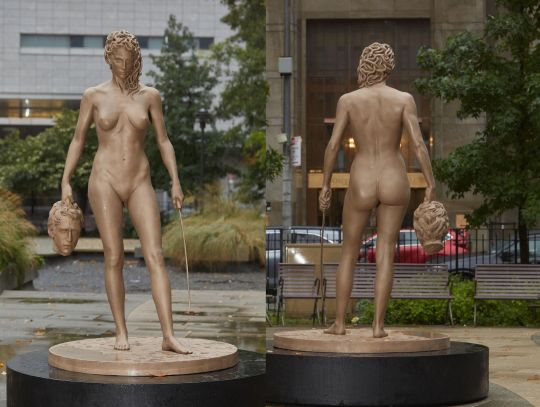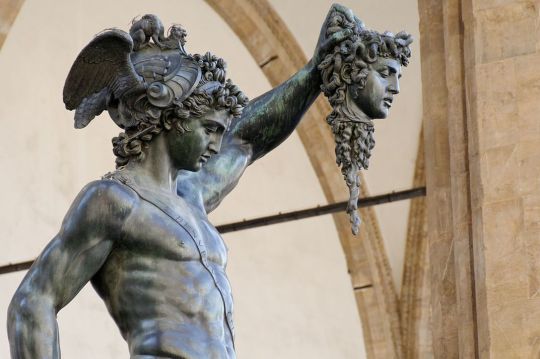#based on art from luciano garbati
Text


“this difference between a masculine victory and a feminine one, that was central to my work. the representations of perseus, he’s always showing the fact that he won, showing the head … if you look at my medusa … she is determined, she had to do what she did because she was defending herself. it’s quite a tragic moment.”
- luciano garbati
#my art#greek gods#perseus#medusa#athena#poseidon#based on art from luciano garbati#greek statues#athenscore#viva la vida#tw: blood#stan medusa for clear skin!!!#medusa and perseus
16 notes
·
View notes
Text
Nude Statue Honoring 'Mother of Feminism' Mary Wollstonecraft Sparks Controversy
https://sciencespies.com/history/nude-statue-honoring-mother-of-feminism-mary-wollstonecraft-sparks-controversy/
Nude Statue Honoring 'Mother of Feminism' Mary Wollstonecraft Sparks Controversy

A statue honoring 18th-century Enlightenment philosopher Mary Wollstonecraft is attracting ire following its installation in London this week. Featuring a nude woman standing atop a twisted mass of female forms, the artwork quickly drew criticism from observers who viewed it as an inappropriate tribute to an intellectual often called the “mother of feminism.”
The silver-toned bronze sculpture, created by British artist Maggi Hambling, is located on Newington Green, Islington, close to where the author once lived. Its base is engraved with a quote from Wollstonecraft: “I do not wish women to have power over men, but over themselves.”
Speaking with the Guardian’s Alexandra Topping, feminist writer Caroline Criado-Perez, who previously led efforts to install a statue of suffragist Millicent Fawcett in London’s Parliament Square, says, “I don’t for a second want to take away from the huge effort that they put into doing this, it is an amazing achievement, but what a waste of all the hard work.”
She adds, “I honestly feel that actually this representation is insulting to her. I can’t see her feeling happy to be represented by this naked, perfectly formed wet dream of a woman.”
Hambling, for her part, tells the Evening Standard’s Robert Dex that the nude figure is not meant to depict Wollstonecraft, but women of all eras.
“She’s [an] everywoman and clothes would have restricted her,” the artist says. “Statues in historic costume look like they belong to history because of their clothes.”
Regarding the slim, muscular body of the woman depicted in the statue, Hambling says, “As far as I know, she’s more or less the shape we’d all like to be.”
The polarizing statue is the result of a decade-long effort by the Mary on the Green campaign, which raised £143,300 (about $189,200 USD) for the artwork. Organizers pointed out that more than 90 percent of London’s statues commemorate men, while key female figures like Wollstonecraft have often gone unrecognized.

Wollstonecraft is best known as the author of A Vindication of the Rights of Women.
(edenpictures via Flickr under CC BY 2.0)
“Mary Wollstonecraft was a rebel and a pioneer, and she deserves a pioneering work of art,” Mary on the Green campaign chair Bee Rowlatt tells BBC News. “This work is an attempt to celebrate her contribution to society with something that goes beyond the Victorian traditions of putting people on pedestals.”
In an interview with the Guardian, Rowlatt adds, “We could have done something really, really boring and ordinary, and, and very Victorian and old fashioned. And, you know, I would be having a slightly easier day today.”
Many people on social media pointed to the contrast between the Wollstonecraft statue and those honoring significant male historical figures.
“Imagine if there was a statue of a hot young naked guy ‘in tribute’ to eg Churchill,” wrote columnist and author Caitlin Moran on Twitter. “It would look mad. This, also, looks mad.”
Wollstonecraft is best known for A Vindication of the Rights of Woman, a 1792 essay that advocated equal education for girls and the admission of women into professional occupations. She was part of an influential, London-based group of radical thinkers that counted Thomas Paine, William Goodwin and William Blake among its other members; her writing laid the groundwork for 19th-century campaigns for women’s suffrage and rights under the law. Wollstonecraft died in September 1797 at just 38 years old, 11 days after giving birth to Mary Wollstonecraft Shelley, author of Frankenstein.
Last month, a statue titled Medusa With the Head of Perseus sparked a similar spate of controversy after it was installed across the street from the New York City courthouse where Harvey Weinstein stood trial. Designed by artist Luciano Garbati, the seven-foot bronze sculpture shows the snake-haired gorgon naked, wielding a sword in one hand and holding Perseus’ severed head in the other. Though some observers heralded the work as a stunning example of feminist art, others questioned the value of placing a male artist’s likeness of a naked, conventionally beautiful woman in such a prominent location for the #MeToo movement.
Writing for the Guardian, columnist Rhiannon Lucy Cosslett calls attention to parallels between the two statues: “Medusa is shown as a slender, toned, idealized figure, suggesting her creator suffers from the same problem as Hambling: a lack of creativity, a consequent falling back on the visual symbols that we are told epitomize great art (perky breasts) with the false belief that fidelity to those conventions will prevent anyone from pointing out their banality.”
Cosslett concludes, “I call it the ‘It’s a naked lady, so it must be art’ syndrome.”
#History
1 note
·
View note
Text
Why a New Statue of Medusa Is So Controversial
https://sciencespies.com/history/why-a-new-statue-of-medusa-is-so-controversial/
Why a New Statue of Medusa Is So Controversial

A statue that inverts the Greek myth of Medusa’s beheading now stands across the street from the Manhattan court where disgraced film executive Harvey Weinstein stood trial. Titled Medusa With the Head of Perseus, the seven-foot bronze sculpture depicts the snake-haired gorgon naked, wielding a sword in one hand and holding Perseus’ head in the other.
Per a statement, the work—created by artist Luciano Garbati in 2008—reacts to Renaissance sculptor Benvenuto Cellini’s Perseus With the Head of Medusa (1545–1554). Both, in turn, are based on a version of a Greek myth relayed in Ovid’s Metamorphoses.
According to legend, Poseidon, the god of the sea, raped a maiden named Medusa in the temple of Athena. Blaming Medusa for the temple’s defilement, Athena turned her into a monstrous gorgon capable of transforming those who looked at her into stone. Later, the demigod Perseus beheaded Medusa as part of a heroic quest.
“While predating modernity by thousands of years, the story of a woman who was blamed, chastised, and shamed for her assault is unfortunately timeless,” notes Valentina Di Liscia for Hyperallergic.
In Cellini’s sculpture, Perseus stands naked atop of Medusa’s corpse, holding her head aloft in victory. As Garbati told Quartz’s Annaliese Griffin in 2018, seeing the work as a child led him to imagine a reversal of its dynamic.
“There are lots of depictions of Medusa, and they are always describing the myth at its worst,” the artist said. “… What would it look like, her victory, not his? How should that sculpture look?”
Garbati’s statue won fame online following the exposure of Weinstein’s sexual crimes and the emergence of the #MeToo movement. In 2018, an image of the statue circulated on social media alongside the caption “Be grateful we only want equality and not payback.”

Garbati’s work responds to Renaissance artist Benvenuto Cellini’s Perseus with the Head of Medusa.
( Marie-Lan Nguyen via Wikimedia Commons under CC-BY 2.5)
New York–based photographer Bek Andersen spearheaded efforts to install the statue in Manhattan, working with Garbati to outline a proposal for the city’s Art in the Parks program, reports Hyperallergic. Anderson also founded Medusa With The Head (MWTH), an art collective that strives to reframe classical narratives. In MWTH’s view, Garbati’s work asks, “[H]ow can a triumph be possible if you are defeating a victim?”
Some, however, are skeptical of the statue’s status as feminist art. On social media, notes Tessa Solomon for ARTnews, a number of critics argued that the statue would make more sense as a #MeToo statement if Medusa were decapitating her rapist, Poseidon. Others questioned the feminist value of placing a male artist’s likeness of a naked, conventionally beautiful woman in such a prominent location.
“#Metoo was started by a Black woman, but a sculpture of a European character by a dude is the commentary that gets centered? Sigh,” wrote activist Wagatwe Wanjuki on Twitter.
Curbed art critic Jerry Saltz, meanwhile, deemed the statue “conceptual art 101 at its most obvious and simplistic. Anyone who sees the statue, reads the title, and is reminded of the original myth will instantly ‘get it.’ That’s all there is after that, other than the Playboy magazine–like nudie realism.”
Added Saltz, “[S]he’s still the total object of the male gaze here, not of thought, fear, admiration, pathos, power, agency, or anything other than male idiocy.”
Responding to the criticism, Andersen tells AdWeek’s David Griner that she doesn’t “think any reaction could be considered ‘wrong.’”
The photographer explains, “It is an emotionally charged sculpture, and it is understandable that viewers have a strong reaction to the work. The reality is that mythology and history are both told from the perspective of a narrator with an implicit bias. But the inversion of the myth destabilizes what many consider to be a fixed history, and that can be an uncomfortable idea.”
Medusa With the Head of Perseus will be on view at Collect Pond Park, across the street from the New York County Criminal Courthouse, through April 2021.
As Andersen says to the New York Post’s Jackie Salo, “My hope is that when people walk out of the courthouse, they will connect with [the statue] and they will have either have accomplished a comfortable sense of justice of themselves or feel empowered to continue to fight for equality for those being prosecuted.”
#History
1 note
·
View note